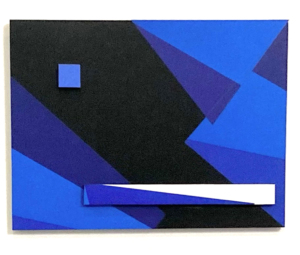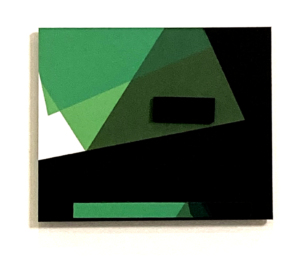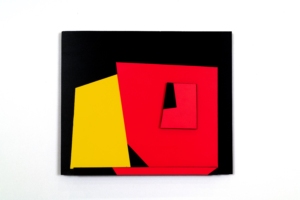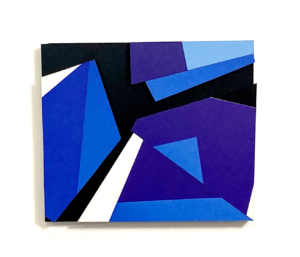Willard Boepple’s “Shards” fuse two art forms, sculpture and monoprints, to make a third which is sui generis and yet partakes of both of the others. Most intimately, the “Shards” bear a relation to the intensely coloristic monoprints that Boepple has been making since roughly 2004 in collaboration—following his choices and decisions—with Kip Gresham, a master printmaker in Cambridge, England. As described by Karen Wilkin in her indispensable book on the artist:
Each shape goes down on the paper as an expanse of uninflected, transparent color. [The shapes determined by stencils prepared beforehand.] As other shapes are added, the overlapping hues create new densities and new colors. Changing the sequence can further alter these tonal and chromatic relationships, creating new spatial suggestions, so that we read each of these unique images differently.1
“New spatial suggestions” is right. In fact the monoprints, for all their coloristic brilliance, are manifestly the work of a sculptor as one tracks not just the interaction of the hues but also the sense of implied physical relationships among the different shapes—sometimes simply a matter of overlap, as if in a shallow three-dimensional space, but often something more, an implied continuity from one shape to the next, as if across a sharp spatial “fold.” Put slightly differently, the pleasures the monoprints offer the viewer are structural as well as color-istic. It’s a marker of Boepple’s originality that, straight-forward as they are, nothing quite like his monoprints have been seen before.

As for the “Shards”: Boepple chooses a monoprint that he likes and has a good high resolution image of and sends it to an industrial printer (who does billboards, big banner signage, and truck and bus wraps); the printer’s team then prints the image on adhesive-backed vinyl to a sharp resolution and color fast-ness, to any size Boepple requests—sometimes one to one but usually larger. In the studio, the vinyl images, which for all intents and purposes have almost no thickness, are adhered to 1/4-inch PVC (polyvinal chloride, a kind of plastic) so that Boepple then has a physical version of the monoprint that can be cut, bent, layered, and glued. (“The print made a thing, a miracle,” is how Boepple puts it.) At which point the prints-made-things are cut up, folded, layered, butted, and stacked, until Boepple is satisfied with the result.

So much for the making of the “Shards”—what about their “formal” character? Several points seem clear:
1) They seem to require a modest scale, on the order of roughly one foot in width versus eight or so inches in height (but this may change). At a larger size the relations among the different elements would lose something of their mutually energizing character.
2) The PVC itself is usually black, and in fact all the “Shards” are staged against a black ground or basis. This matters not just in terms of the overall image but also with respect to the 1/4-inch thickness or cross-section of the PVC. The other colors—reds, yellows, blues, greens, strong hues, no pastel tints—contrast not just with one another but also, everywhere, with black.
3) The basic overall shape of almost all the “Shards” is rectangular, with the horizontal dimension longer than the vertical one. This means that the “Shards” retain a certain “pictorial” character, which matters because otherwise—if the “Shards” themselves had eccentric external shapes—their character as objects (as “mere” objects, I’m inclined to say) would be emphasized to the detriment of their esthetic effect.

4) In keeping with that, the arrangement of the cut-out shapes is in all cases designed to play against the enclosing rectangle. Thus shapes that protrude beyond the limits of the “Shard,” as they sometimes do, nevertheless refer, respond, or react to the rectangle. Frequently, at least one element, often a quite small one, a sort of dash or tab, is placed so as to echo or locate the enclosing format. This too reinforces the “pictorial” aspect of the “Shards” (think of Cubist collage).
5) It matters tremendously that the individual shapes, whether attached to PVC (therefore having a 1/4-inch thickness) or affixed directly to the basic rectangle, are emphatically cut. Recently Boepple has experimented with curved shapes, but the “Shards” I’ve seen are all based on straight edges and sharply-cut angles, which turn out to carry strongly tactile connotations.
6) And those connotations are given added force by Boepple’s technique of partial layering of shaped pieces of PVC—usually just one layer on top of the basic rectangle, but sometimes—increasingly—two (or more). To repeat: each piece of PVC is 1/4 inch in thickness, so the layering is everywhere restrained, undramatic. But it nevertheless tells: together with the sharp-edged quality of the shapes, the intensity of the color-juxtapositions, and the interplay between the shapes with minimal thickness and the ones backed by PVC, the layering adds a note of enhanced plasticity to the ensemble. Put another way, the “Shards” are at once intensely “pictorial,” for reasons already given, and intensely tactile, which is to say that one’s perception of the “Shards” veers continually between a sense of their strength as compositions—as if in the flat—and their presence as a special sort of material artifact, their character as an entirely new variety of relief. From the first, my sense has been that the “Shards” offer a viewing experience unlike any with which I was previously familiar—though at the same time they exemplify the pursuit of what the photographer Edward Weston called “Form, an unarguably right relationship of shapes, a visual stability in which all components are equally important.” A traditional ideal, here given untraditional realization.

7) One more point. For the most part, Boepple has tended to hang his “Shards” on a wall. But he has also presented them in a different manner—not flat on a table-top but placed on a flat surface with the “Shard” just slightly raised at the top end. In effect this takes something away from their “pictorial” character and adds to a certain sense of three-dimensional, indeed sculptural presence, in a way I personally find strongly appealing. If there is an approximate real-world analogy to their overall look, it might be that of a smallish notebook computer—not that there is anything the least technological in their appearance. But the lowly angled mode of presentation keys the “Shards” all the more strongly to a kind of manual space.
“Unlike any work I have made to date,” Boepple has remarked, “the ‘Shards’ seem to make themselves.” Over the years I have learned to take Boepple at his word. But in this case that “making themselves” nevertheless testifies to the indefatigable resourcefulness of their creator.
[A selection of the “Shards” will be featured in an exhibition in the Fenn Ditton Gallery, Cambridge, England, May 18–June 18, 2023.] Notes
Willard Boepple’s “Shards” fuse two art forms, sculpture and monoprints, to make a third which is sui generis and yet partakes of both of the others. Most intimately, the “Shards” bear a relation to the intensely coloristic monoprints that Boepple has been making since roughly 2004 in collaboration—following his choices and decisions—with Kip Gresham, a master printmaker in Cambridge, England. As described by Karen Wilkin in her indispensable book on the artist:
Each shape goes down on the paper as an expanse of uninflected, transparent color. [The shapes determined by stencils prepared beforehand.] As other shapes are added, the overlapping hues create new densities and new colors. Changing the sequence can further alter these tonal and chromatic relationships, creating new spatial suggestions, so that we read each of these unique images differently.1
“New spatial suggestions” is right. In fact the monoprints, for all their coloristic brilliance, are manifestly the work of a sculptor as one tracks not just the interaction of the hues but also the sense of implied physical relationships among the different shapes—sometimes simply a matter of overlap, as if in a shallow three-dimensional space, but often something more, an implied continuity from one shape to the next, as if across a sharp spatial “fold.” Put slightly differently, the pleasures the monoprints offer the viewer are structural as well as color-istic. It’s a marker of Boepple’s originality that, straight-forward as they are, nothing quite like his monoprints have been seen before.

As for the “Shards”: Boepple chooses a monoprint that he likes and has a good high resolution image of and sends it to an industrial printer (who does billboards, big banner signage, and truck and bus wraps); the printer’s team then prints the image on adhesive-backed vinyl to a sharp resolution and color fast-ness, to any size Boepple requests—sometimes one to one but usually larger. In the studio, the vinyl images, which for all intents and purposes have almost no thickness, are adhered to 1/4-inch PVC (polyvinal chloride, a kind of plastic) so that Boepple then has a physical version of the monoprint that can be cut, bent, layered, and glued. (“The print made a thing, a miracle,” is how Boepple puts it.) At which point the prints-made-things are cut up, folded, layered, butted, and stacked, until Boepple is satisfied with the result.

So much for the making of the “Shards”—what about their “formal” character? Several points seem clear:
1) They seem to require a modest scale, on the order of roughly one foot in width versus eight or so inches in height (but this may change). At a larger size the relations among the different elements would lose something of their mutually energizing character.
2) The PVC itself is usually black, and in fact all the “Shards” are staged against a black ground or basis. This matters not just in terms of the overall image but also with respect to the 1/4-inch thickness or cross-section of the PVC. The other colors—reds, yellows, blues, greens, strong hues, no pastel tints—contrast not just with one another but also, everywhere, with black.
3) The basic overall shape of almost all the “Shards” is rectangular, with the horizontal dimension longer than the vertical one. This means that the “Shards” retain a certain “pictorial” character, which matters because otherwise—if the “Shards” themselves had eccentric external shapes—their character as objects (as “mere” objects, I’m inclined to say) would be emphasized to the detriment of their esthetic effect.

4) In keeping with that, the arrangement of the cut-out shapes is in all cases designed to play against the enclosing rectangle. Thus shapes that protrude beyond the limits of the “Shard,” as they sometimes do, nevertheless refer, respond, or react to the rectangle. Frequently, at least one element, often a quite small one, a sort of dash or tab, is placed so as to echo or locate the enclosing format. This too reinforces the “pictorial” aspect of the “Shards” (think of Cubist collage).
5) It matters tremendously that the individual shapes, whether attached to PVC (therefore having a 1/4-inch thickness) or affixed directly to the basic rectangle, are emphatically cut. Recently Boepple has experimented with curved shapes, but the “Shards” I’ve seen are all based on straight edges and sharply-cut angles, which turn out to carry strongly tactile connotations.
6) And those connotations are given added force by Boepple’s technique of partial layering of shaped pieces of PVC—usually just one layer on top of the basic rectangle, but sometimes—increasingly—two (or more). To repeat: each piece of PVC is 1/4 inch in thickness, so the layering is everywhere restrained, undramatic. But it nevertheless tells: together with the sharp-edged quality of the shapes, the intensity of the color-juxtapositions, and the interplay between the shapes with minimal thickness and the ones backed by PVC, the layering adds a note of enhanced plasticity to the ensemble. Put another way, the “Shards” are at once intensely “pictorial,” for reasons already given, and intensely tactile, which is to say that one’s perception of the “Shards” veers continually between a sense of their strength as compositions—as if in the flat—and their presence as a special sort of material artifact, their character as an entirely new variety of relief. From the first, my sense has been that the “Shards” offer a viewing experience unlike any with which I was previously familiar—though at the same time they exemplify the pursuit of what the photographer Edward Weston called “Form, an unarguably right relationship of shapes, a visual stability in which all components are equally important.” A traditional ideal, here given untraditional realization.

7) One more point. For the most part, Boepple has tended to hang his “Shards” on a wall. But he has also presented them in a different manner—not flat on a table-top but placed on a flat surface with the “Shard” just slightly raised at the top end. In effect this takes something away from their “pictorial” character and adds to a certain sense of three-dimensional, indeed sculptural presence, in a way I personally find strongly appealing. If there is an approximate real-world analogy to their overall look, it might be that of a smallish notebook computer—not that there is anything the least technological in their appearance. But the lowly angled mode of presentation keys the “Shards” all the more strongly to a kind of manual space.
“Unlike any work I have made to date,” Boepple has remarked, “the ‘Shards’ seem to make themselves.” Over the years I have learned to take Boepple at his word. But in this case that “making themselves” nevertheless testifies to the indefatigable resourcefulness of their creator.
[A selection of the “Shards” will be featured in an exhibition in the Fenn Ditton Gallery, Cambridge, England, May 18–June 18, 2023.] Notes

nonsite.org is an online, open access, peer-reviewed quarterly journal of scholarship in the arts and humanities. nonsite.org is affiliated with Emory College of Arts and Sciences.